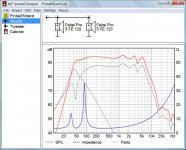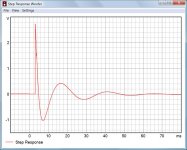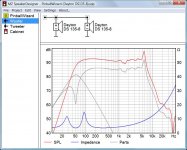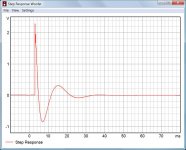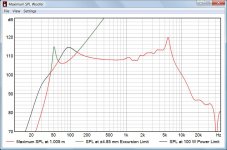I'm looking to build some speakers for a cramped living room space. The way the room is configured, I really have no choice but to mount the speakers on the wall on either side of my TV. No plan for a subwoofer at the moment, and I'm not sure where I'd put one. Once these are built, I'm getting rid of 3-way Sony towers with dual 7" woofers (which are placed in awful locations in the room), and I'd like to build something comparable in bass response. So I want these speakers to be loud, small and low. Asking too much, I know, but these 5" Faital speakers seem to be beasts on paper (at least to me with WinISD and limited knowledge)
Current Plan:
Possible reasons not to do MTM:
Questions:
Thanks!
Current Plan:
- MTM for increased sensitivity, w/ Faital 5FE120 and Tang Band 25-302SH
- ~16.5L bass reflex
- 100dB @ 40Hz according to WinISD
- X-Overs with MiniDSP
- 4x100W Tripath Amp board (so I can hide my amp on top of a bookshelf)
Possible reasons not to do MTM:
- 20ft high ceilings
- I need to mount the speaker up high so that the center would be about 75in off the ground, and the couch is 120in away from the wall, so that comes out to about 9.5degrees off vertical axis when seated on the couch.
Questions:
- I'm thinking maybe I could angle the baffle about 10degrees down, but might be tough with my limited carpentry skills. Good idea?
- I don't want to get into building a 2.5 since I wanted to try the 'every speaker has its own amp' idea. However, would a TMM with a flat baffle be a safer bet here than a MTM with a funky downward angled baffle? Or maybe even worse a MTM mounted high on the wall with a flat baffle?
- Or should I build a TM? The dual Faital 5" sounds appealing because I can supposedly (according to WinISD) get 100dB @ 40Hz out of a 16.5L box. Too good to be true? Are there any single drivers out there that can match this performance?
Thanks!
not sure i would use BR for wall mounted speaker
but may depend on the woofer
Why do you say that and why would the qualities of the woofer matter? Does it make things worse if I'm planning on placing the port at either the top or the bottom of the enclosure due to the need for a long port?
for a very long time there have been bookshelve speakers, and free standing 'enthusiast' speakers
or alternatively, speakers that are designed work 'up against the wall', or in a corner
and all those 'in between'
basicly it is about room gain, or loss of it
why the woofer makes a difference ?
because you can cheat most of the above 'limitations' by choosing a woofer that goes against it
say, if you want BR and use it 'up against the wall', then it might work better if designing a 'tight BR'
which basicly means using a woofer with lower Qts
and I really wish I could say 'it is that simple' ... but it probably is not 🙂
or maybe it is all just based too much on educational audiophile stereotype thinking 😀
or alternatively, speakers that are designed work 'up against the wall', or in a corner
and all those 'in between'
basicly it is about room gain, or loss of it
why the woofer makes a difference ?
because you can cheat most of the above 'limitations' by choosing a woofer that goes against it
say, if you want BR and use it 'up against the wall', then it might work better if designing a 'tight BR'
which basicly means using a woofer with lower Qts
and I really wish I could say 'it is that simple' ... but it probably is not 🙂
or maybe it is all just based too much on educational audiophile stereotype thinking 😀
btw, had another at the 5" woofer
5liter Vas, and 0.47 Qts
not sure it will work in BR
actually, its not really a woofer
it is designed to work with a subwoofer
and with a subwoofer present, there will be no need for BR
closed will do fine
benefit of such driver design is higher sensitivity
the down side is relatively short Xmax
so it will probably need some sort of highpass filter to take out the lows
more drivers will help on this 'issue'
question is how many are needed to make significant difference
usually these kinds of small PA drivers are special designs for large arrays with many driver
in hifi, maybe better for midrange use
5liter Vas, and 0.47 Qts
not sure it will work in BR
actually, its not really a woofer
it is designed to work with a subwoofer
and with a subwoofer present, there will be no need for BR
closed will do fine
benefit of such driver design is higher sensitivity
the down side is relatively short Xmax
so it will probably need some sort of highpass filter to take out the lows
more drivers will help on this 'issue'
question is how many are needed to make significant difference
usually these kinds of small PA drivers are special designs for large arrays with many driver
in hifi, maybe better for midrange use
Too good to be true?
Of course. Xmax of the Faital 5FE120 in normal reading actually is 3.25 mm and the sensitivity, based on manufacturer TS-parameters, is more likely around 86 dB.
Drivers having a Qts of almost 0.5 and a high resonant frequency are not really suited to go very low. You only achieved that by choosing a non flat alignment (EBS3 ?), which has a peak at 50 Hz and a poor transient response (boomy).
Regarding MTM there are two things to consider. Wiring two Faital drivers in parallel results in a load of only 2.7 ohm, which is too low for many amplifiers. Wiring the drivers in series gives a load of 10.8 ohm, and that's pretty high. Thus, the best solution would be two 4 ohm drivers wired in series IMO. Further, MTMs not having the tweeter on ear height require a fairly low crossover frequency of 1.5-2 kHz. I doubt the Tang Band tweeter can do that.
Ok Ok... Maybe I should reconsider. Thanks for the help and input, and sorry for my ignorance! I'm still new to this stuff. There are still a few points I'd like to clear up for my own education though.
Well that would certainly drop down the max SPL graph in WidISD... How is Xmax supposed to be calculated? I imagine Faital isn't the only manufacturer out there padding that value.
Yeah I suppose that's another problem. I was guessing, though, that the load at DC would be less important to the amplifier than the 'minimum impedance' number, which I'm guessing is the lowest impedance at a frequency above Fs? If I still think I want to do an MTM this could be good to know. Using the minimum impedance number from the datasheet puts two Faitals in series at 3.1ohm, which is still tough but a bit more doable.
I didn't really choose an alignment, I just kind of played around with box size and tuning freq. That Qts of 0.477 is on the high side traditionally, but it seemed to look ok on the graphs. Maybe you can't rely on your modeling program for everything, but let's say for the sake of argument that if it looks good on the graphs, how do you know it won't be good?
For instance, the modeled bass frequency response didn't show any peaks on the graph, and the modeled group delay was under one cycle time. Worst group delay spot was 19ms somewhere around 40Hz, which I thought was supposed to be inaudible. Am I running into limitations with WinISD or am I not looking at or thinking about the right things?
Also, is transient response related to group delay or is it something entirely different?
Yeah you're probably right about that tweeter having trouble at those frequencies, and whether it's at ear height or not it sounds like I'd want to get that crossover point down to about that range anyway. However, does it matter if the speakers are at ear height if I angle them downwards (angled baffle or fly them PA speaker style)?
I'm starting to think I might just build the Zaph Audio SR71 or something similar instead.
Xmax of the Faital 5FE120 in normal reading actually is 3.25 mm
Well that would certainly drop down the max SPL graph in WidISD... How is Xmax supposed to be calculated? I imagine Faital isn't the only manufacturer out there padding that value.
Wiring two Faital drivers in parallel results in a load of only 2.7 ohm
Yeah I suppose that's another problem. I was guessing, though, that the load at DC would be less important to the amplifier than the 'minimum impedance' number, which I'm guessing is the lowest impedance at a frequency above Fs? If I still think I want to do an MTM this could be good to know. Using the minimum impedance number from the datasheet puts two Faitals in series at 3.1ohm, which is still tough but a bit more doable.
Drivers having a Qts of almost 0.5 and a high resonant frequency are not really suited to go very low. You only achieved that by choosing a non flat alignment (EBS3 ?), which has a peak at 50 Hz and a poor transient response (boomy).
I didn't really choose an alignment, I just kind of played around with box size and tuning freq. That Qts of 0.477 is on the high side traditionally, but it seemed to look ok on the graphs. Maybe you can't rely on your modeling program for everything, but let's say for the sake of argument that if it looks good on the graphs, how do you know it won't be good?
For instance, the modeled bass frequency response didn't show any peaks on the graph, and the modeled group delay was under one cycle time. Worst group delay spot was 19ms somewhere around 40Hz, which I thought was supposed to be inaudible. Am I running into limitations with WinISD or am I not looking at or thinking about the right things?
Also, is transient response related to group delay or is it something entirely different?
MTMs not having the tweeter on ear height require a fairly low crossover frequency of 1.5-2 kHz. I doubt the Tang Band tweeter can do that
Yeah you're probably right about that tweeter having trouble at those frequencies, and whether it's at ear height or not it sounds like I'd want to get that crossover point down to about that range anyway. However, does it matter if the speakers are at ear height if I angle them downwards (angled baffle or fly them PA speaker style)?
I'm starting to think I might just build the Zaph Audio SR71 or something similar instead.
Faital gives perfectly fine info, just have to read it right 😉.Well that would certainly drop down the max SPL graph in WidISD... How is Xmax supposed to be calculated? I imagine Faital isn't the only manufacturer out there padding that value.
gap height = 6mm, overhung coil height = 12.5mm. When the coil moves 3.25mm, the edge of the coil reaches the edge of the gap, and that's xmax.
how do you know it won't be good?
I don't say it not good, I just wanted to make clear the Faital driver is not so unique and outstanding as the OP suggests and the bass reflex alignment also has a downside. Speaker design always is a tradeoff between different aspects. 🙂
Attachments
Try the Dayton "designer" series woofers for getting 100dB in smallish enclosures with some bass. Not flat to 40Hz bass, but some bass. I'm currently working on a 20 liter compact 3-way with a goal of highest possible SPL while flat to approx. 60Hz, settled on a pair of DS175-8. I do believe it will get quite loud.
P.S. (that's a multi-version project, so I might as well mention while I'm here that I'm still open for woofer suggestions toward that goal).
P.S. (that's a multi-version project, so I might as well mention while I'm here that I'm still open for woofer suggestions toward that goal).
Last edited:
Thanks so much for posting those graphs Dissi. I took a look at the website, your software looks pretty slick. I hesitate to download the trial for fear I will be sad when the trial period runs out... That ringing looks to be around 60Hz or so. Is that around where you tuned the enclosure? I may have to download the trial version just to see what some other transient responses look like in comparison.
dumptruck, I never looked at the DS175-8, not sure why. It models really impressively in a small box. You mentioned a 3-way. I wonder if it will be able to handle the mids up to 1.5k or 2k in a 2-way? The graph at least looks kind of ragged in the mids to me.
dumptruck, I never looked at the DS175-8, not sure why. It models really impressively in a small box. You mentioned a 3-way. I wonder if it will be able to handle the mids up to 1.5k or 2k in a 2-way? The graph at least looks kind of ragged in the mids to me.
I may have to download the trial version just to see what some other transient responses look like in comparison.
Shame on me, the program is still not released...😡
Attached is an example of a moderate bass reflex alignment: two Dayton DS135-8 in 10 liters. It has less bass extension, but a smooth rolloff and a better transient response.
The big advantage of MTM is the high maximum SPL in the midrange IMO. A conventional 2-way only makes 102-104 dB, having 6 more dB of headroom makes a difference.
Attachments
5FE120, not ported, 6x9 PR in mine
I am using a 6x9 PR on the back of a .25 cuft cab-about 6 or 7 litres.
I really like this little speaker. I measured it without a proper test baffle, and had some concerns, but I put it in my cabinet, in place of aluminum 5.5" woofer and this one is much more sensitive, powerful, and has nice tone. It has tight bass. It measures about 6db down at 60 hz in my small living room, but essentially flat to 105hz. That said, and with me used to large and capable speakers, the impression of bass is very solid. The really low notes are pretty much absent though.
The system is 3 way, so whatever uneveness the 5FE120 may have in the midrange(seen in my initial casual measurement), does not show up when the whole system is measured. I should try a 2way, naturally. The 3way crossover uses a lot of pieces for such a small speaker. The mid is a Peerless by Tymphany TC9FD18-08 3-1/2", which is worth searching for in the forums, on its own merits. Tweeter is 1" dome, no name, but nice.
I think these may make great open baffle mids. I have the Faital Pro 4FE35 used as such, and they are nice.
I am using a 6x9 PR on the back of a .25 cuft cab-about 6 or 7 litres.
I really like this little speaker. I measured it without a proper test baffle, and had some concerns, but I put it in my cabinet, in place of aluminum 5.5" woofer and this one is much more sensitive, powerful, and has nice tone. It has tight bass. It measures about 6db down at 60 hz in my small living room, but essentially flat to 105hz. That said, and with me used to large and capable speakers, the impression of bass is very solid. The really low notes are pretty much absent though.
The system is 3 way, so whatever uneveness the 5FE120 may have in the midrange(seen in my initial casual measurement), does not show up when the whole system is measured. I should try a 2way, naturally. The 3way crossover uses a lot of pieces for such a small speaker. The mid is a Peerless by Tymphany TC9FD18-08 3-1/2", which is worth searching for in the forums, on its own merits. Tweeter is 1" dome, no name, but nice.
I think these may make great open baffle mids. I have the Faital Pro 4FE35 used as such, and they are nice.
Sorry for the thread bump, but what do you guys think of the 2.7 ohm impedance of the 5FE120 in a MTM or TMM config? Will it fry amps?
5FE120 is really cheap in Europe.
5FE120 is really cheap in Europe.
Sorry for the thread bump, but what do you guys think of the 2.7 ohm impedance of the 5FE120 in a MTM or TMM config? Will it fry amps?
5FE120 is really cheap in Europe.
According to my sims, a pair in parallel drop down to 3ohm around 200 to 300hz but the electrical phase is -45 4ohm at 140hz.
- Status
- Not open for further replies.
- Home
- Loudspeakers
- Multi-Way
- MTM w/ Faital 5FE120 good for my room?
